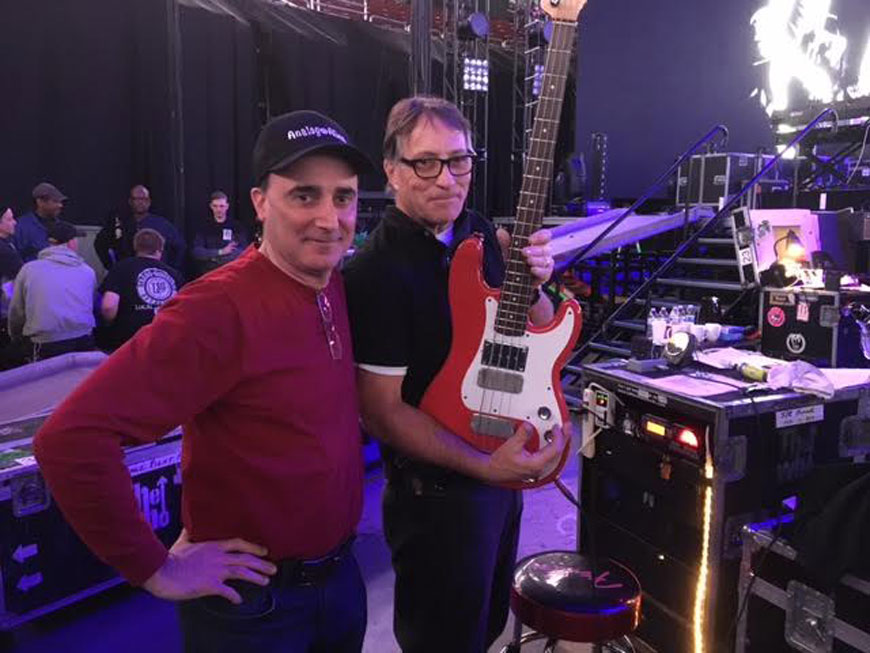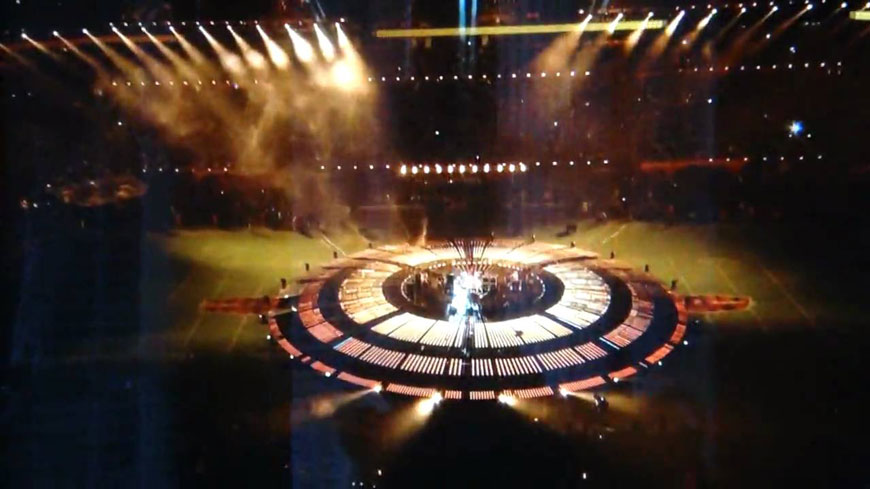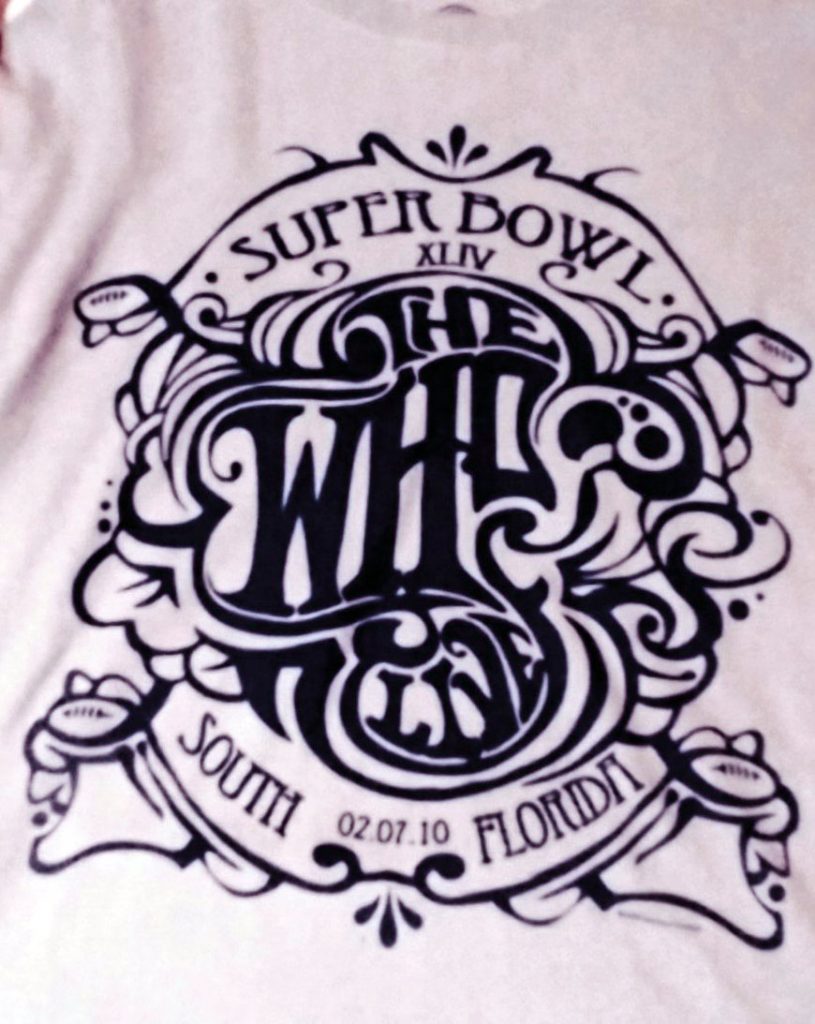9 Feb 2021
Brian Kehew’s Offstage Blog: Super Bowl 2010 Part II

Above: Guitar technician Michael Kaye (right) with Jack Napoli of Analog Alien Guitar Pedals
Guitar technician Michael Kaye worked with The Who from the 2006 Endless Wire tour for a decade, in charge of Pete’s “systems” (pedals, power, amps, etc). He’s a fantastic technician, having spent decades handling stage gear for Paul Simon, Steve Stills, Bruce Springsteen, Shania Twain and currently working with Trey Anastasio (Phish). By special request, he brings us his recollections of the big event:
“I worked with Bruce Springsteen and the E Street Band on the Super Bowl halftime show in 2009, a year before The Who. That was a less complex endeavor, as there were fewer carts (rolling platforms) making up a smaller stage and everything was rectangles and squares. We had a real issue during rehearsals getting power-extension cables all the way out for the stage in time: Some equipment needed time to boot-up or required settings entered once turned on, and tube/valve amplifiers needed to warm up to work. We had requested a UPS (Uninterruptible Power Supply; basically a battery-back-up unit that supplies all needed power, even when nothing is plugged into the wall source) and the request was refused!
This became an issue over and over, as the stage crew were making adjustments with the band on stage and the count-off already starting . . . Max Weinberg playing the beat, Bruce addressing the worldwide audience and seven guys under the stage pushing buttons trying/racing to make the gear work before they start playing, crossing fingers for warm tubes/valves in the amps. It was close, and just barely worked in time. And so . . .
Part 1: From the first discussion for the 2010 Super Bowl with The Who’s production manager, Roy Lamb, I requested that we rent a 240 volt UPS (battery backup power) in England and have it shipped to Miami with the gear. Done.
Part 2: . . . was pure subterfuge: The box would only ever be referred to as a “240-volt transformer” – never a “UPS”, because Americans are confused and afraid of English 240-volt power and would naturally stay a distance – they wouldn’t even look at it! Good.
There are many rehearsals and run-throughs, and through these I never activated the battery-power function, so we never raised any kind of issue or drew attention to electrical power issues . . . so the subterfuge worked! They were not suspicious at all.
On the day of the Super Bowl, when The Who cart with the left half of the drum set and all Pete’s amps rolled out through the tunnel to the field – all of Pete’s amps were already switched on, the valves were warming-up to sound great, and I was testing it all to ensure that Pete’s trust was not misplaced. Yes: It was already perfect and flawless before the band came up.
I still don’t know why the producers were against using a UPS . . . they only said something about “we don’t want another Rolling Stones” – whatever that meant.

DROPPING THE BALL (or stage, in this case)
For the Super Bowl halftime show, the many pieces of the stage (plus the sound and the lights and the pyro and everything, totalling over 60 gear carts) are each pulled, pushed and dragged onto the field by teams of volunteers. With all entering through nine openings (at this Miami Stadium) in a specific order so as to be assembled in the very few minutes available.
Before The Who even came to Florida, volunteer teams were assembled with chosen Captains and Guides to direct them and make adjustments as the order and relative speeds. Most of this happens outside the stadium on a grassy practice football field, marked and painted to the correct dimensions with reference lines mirroring the actual Super Bowl field. The teams had been doing this each day and evening before we got there, and these volunteers were keen and eager.
A word about the volunteers; they are truly donating their time, and not paid. Some are experienced stagehands, some are music fans, some are sports fans, some are just the put-upon partners. Once assigned to a cart, the team sticks together – the prestige carts being those involved with the performers’ gear, rather than those given a box of lights stationed 50 feet away.
A little sidetrack here . . . The year previous, I had done this event with Bruce Springsteen and the E Street Band. The gear I cared for was on Cart 5: The Cart 5 support team and I became very tight and we cheered each other on and made sure everyone had sandwiches and drinks whenever they needed that. I would be riding on the cart to hold pieces of gear from bouncing off, and to verbally guide the team. In between times (to keep their spirits up), I would tell rock-and-roll stores of debauchery (not really) and worldwide fun, or show them how to adjust or fix bits of gear for those who were keen. On a run through, one of the ladies was beat; she just looked worn-out. It was quietly explained to me that Kim Holt was in a fight with cancer, and that her family and friends had all gathered to honor and support her wish to be there – to help Bruce for this huge event – this team was there for Kim. We had a word and decided that the best course was to have Kim ride on the cart with me, to help hold the gear and cheer on the team of pushers. That worked out just great and being with Kim and her gang took on a deeper meaning. Kim is gone now, she had a good ride – the Cart 5 Team made sure of that!
Back to Miami 2010 and The Who . . . On Wednesday night, the cart teams would do their practice as they had been – but for the first time they would have the added weight of The Who’s equipment on-board.
Cart 2 was a semi-circle, which was to carry the left half of the drum set (one of the two bass drums, a tom-tom, the high hat, and cymbal stands) and then my responsibility: Pete’s four amp stacks each made up of a Fender Vibro-King amp on top of a matching Fender speaker cabinet. Only two stacks are ever used, the other two are spares we have, just in case they are needed. This gear was all secured to the stage surface with tie-downs, ratchet straps, tape (and hopes and dreams). As we had been rehearsing with the band earlier that day, everything was already wired and set to operate if supplied with power (it was not powered, though, for this staging rehearsal) and a guitar plugged in (these were safely stored during this as well).
The Who crew – every one jet-lagged and beat from a long, long, long day – were headed home after the rehearsal on the grass, and in vans leaving for hotel when we got some news. Cart 2 under the weight had collapsed sending the gear to the ground from about 14 feet up. One of the large aircraft-type tires had found a depression in the field and then caught. The undercarriage/frame of the cart gave way and dumped everything down onto the grass and dirt. We ran back and started to pick up the pieces and assess what was still in good shape – and the larger pile, which was what had really been broken.
Of Pete’s four amps, all were damaged – all the glass tubes/valves shattered, a transformer hanging here, knobs broken-off, and some of the cabinets were broken. All the specialised cabling was damaged, too. I started my list of “to-do” things! Cart 2 itself was hauled off for the fabricators to weld up and brace. And the drums were scratched, I think (nothing fatal or very serious, but no time to remake a custom one-of-a-kind kit.)
Early the next morning, I was outside a music store with a shopping list and my plans A, B, and C to do, depending on what was in-stock. Most of the valves I could replace from the supplies we always travel with. But I needed cables – lots of them – maybe some pre-built, but better to get raw cable and ends I can solder to get the specific length function and usually better quality. So I raced through the store spending, spending, spending. Back at the stadium, I managed to get just one of the four broken amps working, but that cabinet was broken! We had two good Vibro-King cabinets and two bad, so I swapped this amp into a good cabinet and was able to have just one stack working for Pete when the band came in for rehearsals, which is the minimum he needed.
As they played through my favourite songs (I’m a child of Who’s Next) I kept opening amps to assess and maybe swap parts. The amp with the knobs dashed off (and the internals broken) had good transformers, so the amps with the bad transformer was about to get a transplant! So much soldering and swapping, plus some sweating and coffee, as longtime guitar tech Alan Rogan kept one eye on Pete and the one working amp, and another eye on me! The hoped-for goal would be just two working amps, since the other two were too far gone and would require a total refit later (after the Super Bowl event). By the end of Thursday, that second amp with salvaged and swapped parts was indeed working. Mission accomplished!
As for cosmetics, the amps had tears and scrapes in the cream-coloured Tolex vinyl and all the rear panels were broken. The rear panels do affect the sound and so the fix needed was an actual replacement: Late-night calls and emails to Fender, brought more calls to their amp cabinetry shop in Mexico. By Saturday, game day, I had new rear panels and a length of Tolex to wrap over the damage. This looks fine at night, from 20 feet, if you squint!
Friday Rehearsals: I had Pete’s two usual amps working well and tested; they were just sounding perfect – huge relief. While Pete, Roger and the band looked at some song arrangement changes, I kept working and came up with a “visual presentation” of the two spare (broken) amp stacks. This included glowing/lighted pilot lights on those otherwise dead amps! So it looked normal (from 20 feet at night . . .) and Pete’s guitar cable is 22 feet.
As I was tidying and cleaning up the scatter of parts, I realised that – with some time – I might be able to fix one of the two badly-broken amp cabinets. Once the band finished, I pulled the amps to my work area while Cart 2 went off for its nightly practice (the weight of the missing amps made up with sandbags) and went to work with some glue, clamps, and wood bracing. I looked at the two busted amps (that had been in my care for four years) and decided I had to try to salvage one of them, by taking the broken amps and tools back to my hotel (which conveniently had a raging disco to cover the noise of my testing!) There, I was able to repair amp No. 3. The fourth had given its all and would never rock again (where is it now?)
On the Super Bowl show day, the carts were rolled onto the field at halftime, placed and connected. I had my secret UPS supplying the amplifiers’ main power. Pete was given his Gibson J200 acoustic by Alan, with his famous No.4 red Stratocaster guitar on a stand. At the last moment, Pete decided he’d like to run the third amp (!) and switched it on so that Rabbit could more clearly hear guitar (even though Rabbit’s parts were already on tape!) Only a day before, that third amp had been a “fake” prop with just a working light! Pete never knew about that, so I was so lucky I’d not given up . . . ”
Michael Kaye

